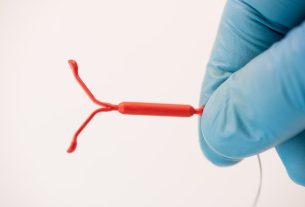Retrograde menstruation is a situation in which menstrual blood, instead of leaving the uterus and being eliminated through the vagina, heads towards the fallopian tubes and pelvic cavity, spreading with no way to exit during menstruation. Thus, fragments of endometrial tissue reach other organs such as the ovaries, intestine or bladder, adhere to their walls, grow and bleed during menstruation, causing a lot of pain.
As endometrial tissue is not eliminated correctly, it is common for retrograde menstruation to be related to endometriosis. However, it is also possible that some women with retrograde menstruation do not develop endometriosis, as their immune system is capable of preventing the growth of endometrial cells in other organs.

Symptoms of retrograde menstruation
The symptoms of retrograde menstruation are not always noticed as it is a natural condition in some women. However, in cases where retrograde menstruation causes endometriosis, symptoms such as:
- Shorter menstruation;
- Bleeding without normal signs of menstruation such as cramping, irritability or bloating;
- Intense menstrual cramps;
- Pain in the lower abdomen during menstruation;
- Infertility.
The diagnosis of retrograde menstruation is made by the gynecologist through observation of symptoms and tests such as endovaginal ultrasound and the CA-125 blood test, which is normally indicated with the aim of assessing the person’s risk of developing endometriosis, cyst or ovarian cancer. , for example.
How the treatment is carried out
Treatment for retrograde menstruation must be indicated by the gynecologist according to the signs and symptoms presented by the woman and the risk of endometriosis. Therefore, in most cases the use of ovulation inhibitor medications or the use of contraceptive pills may be indicated.
On the other hand, when retrograde menstruation is related to endometriosis, treatment may indicate the use of anti-inflammatory and analgesic medications to alleviate the symptoms of the disease. In some cases, it may be necessary to induce menopause to control endometriosis or perform surgery to correct problems in the fallopian tubes, preventing the backflow of menstrual blood into the abdominal region.

Sign up for our newsletter and stay up to date with exclusive news
that can transform your routine!
Warning: Undefined array key "title" in /home/storelat/public_html/wp-content/plugins/link-whisper-premium/templates/frontend/related-posts.php on line 12
Warning: Undefined array key "title_tag" in /home/storelat/public_html/wp-content/plugins/link-whisper-premium/templates/frontend/related-posts.php on line 13



